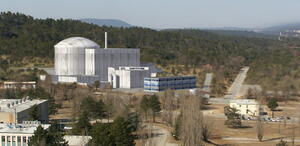Serge Durand: «J'ai un dream!»
For the better part of his 33-year career at CEA, Serge Durand was an organizer and a coordinator—a nuclear engineer turned industrial architect. As Director of CEA's Center for Scientific and Technical Studies (CESTA) from 2001 to 2006, he was instrumental in the construction of Laser MegaJoule (LMJ), the inertial fusion facility being established near Bordeaux.
Now, as head of France's largest nuclear research centre which will celebrate its 50th anniversary in October, Serge Durand has "a dream"—a vision that encompasses the whole of the energy mix of the near future and goes well beyond the Centre's traditional activities and present enclosure. Serge Durand wants to make Cadarache a world-class facility: "the leading centre for all energy-related research and development."
Most of the ingredients which could make this dream come true are already there and ready: the RJH (Reactor Jules Horowitz) will be operational in 2014; the naval propulsion test reactor RES is due to be commissioned in 2011; and with the upgraded test reactor CABRI, Serge Durand says that CEA-Cadarache "will soon rank among the top three fission research centres in the world."
The Centre's labs are already big players in the development of a "demonstrator" for the "Generation IV" line of future fission reactors. Construction of this sodium-cooled fast reactor, named ASTRID, should start in 2015 in Marcoule, another CEA research centre some 30 kilometres north of Avignon.
"In fusion, between ITER and the twenty years of experience we have accumulated in operating Tore-Supra, Cadarache is already Number One, there's no question about that. Our Fusion Institute (IRFM) has been working in support of the ITER Project for several years and we can do even better than being partners and neighbours: we can integrate fusion and fission, organize the innovations and spin-offs for a common benefit."
Fission and fusion are only part of the picture. French President Nicolas Sarkozy's instructions to Bernard Bigot, the Administrator General of CEA, were very clear: Cadarache should be "massively involved" in renewable energies. In many respects, Cadarache already is. The Centre is home to one of the most advanced research platforms on third generation biofuels—obtained from algae, bacteria and biomass—and it has ongoing operations on the thermochemical production of Hydrogen and plans to establish "the largest experimental solar platform in France."
Add the contribution of the Cadarache-based Cap Energie "innovation cluster" of which Serge Durand is President and its network of 370 local companies, research labs, training centres and more than 200 ongoing projects; as well as the possible opening of some 10 hectares of land within the CEA enclosure to private, energy-oriented companies and the extension of the INSTN (1) students' campus around the Château ... and what you obtain is "an energy concentration that would have few equivalents in the world."
Will Serge Durand's dream come true? "Provided we get support from industry and the local governments, I'm confident that it will. Ten to twenty years from now, Cadarache will be the place where fission, fusion and renewable energies meet and interact."



